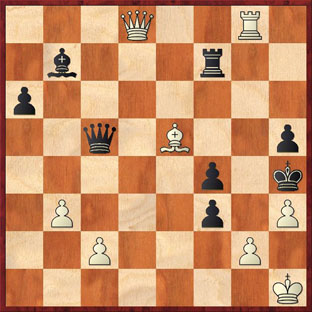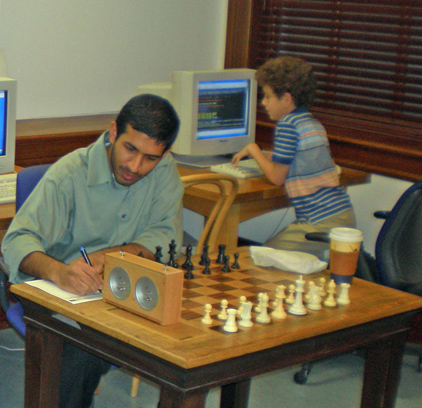“Win with White, draw with Black” — that’s the classic strategy for chess success. But the San Francisco Mechanics have added a new twist, which carried them to a 3-1 victory over the Seattle Sluggers on Monday night. The new strategy is “win with White, win with Bhat.”
The victory put the Mechanics in the driver’s seat in the race for a playoff spot in the U.S. Chess League. If they tie against Dallas next week, the Mechanics can do no worse than tie for second place in the Western division, and even that could only happen if Seattle wins its match with Miami next week by a 4-0 score, or if Carolina wins both of its matches 4-0 (surely the longest of long shots).
The night’s first winner was Vinay Bhat, who outplayed Seattle’s Eric Tangborn on board 2 and stretched his league record this year to an unbelievable 6-0. This is Fischer territory! (Or, for fans of another sport, New England Patriots territory.) “No, not that good,” said Bhat. But Josh Friedel put Bhat’s contribution into perspective. “Without Vinay, we’re just a middle-of-the-pack team. With him, we’re a middle-of-the-pack team plus one match.” In fact, the rest of the team combined has a won-loss record of exactly 50 percent.
The remaining three games finished in rapid succession. On first board, Josh Friedel finally subdued grandmaster Gregory Serper’s tenacious defense in a Kan Sicilian. “He defended long past the point when an ordinary player would have made a mistake,” Friedel said. Friedel’s final combination caught Serper’s king in a crossfire of queen and rook. If Serper defends by interposing his queen on e7, Friedel would trade queens and checkmate with his bishop (see diagram). This attractive victory against strong defense seems like an early candidate for Game of the Week honors.
Final position of Friedel-Serper.
Meanwhile, on board four, 12-year-old whiz kid Daniel Naroditsky clinched the victory for the Mechanics with a draw in a seesaw King’s Indian Defense against Josh Sinanan. That left John Donaldson versus Loren Schmidt, on board three, as the only game still going. Team captain Donaldson, who had been nursing an advantage the whole game, offered a draw after he saw his team had a 2-point lead, and calculated the mathematics of the possible tiebreak scenarios next week.
“Now we just have to take care of business against Dallas,” Donaldson said.
For any chess fans who haven’t seen a U.S. Chess League match live, it’s really an entertaining experience. Don’t expect too much action for the first couple hours. There’s plenty of time to watch Friedel twirl his hair, to wonder if Naroditsky could possibly place his face any closer to the computer monitor, and to ponder the psychological significance of the fact that all three of the elder players like to play the moves on a real chessboard, while Naroditsky is content to play all of his moves in cyberspace. (In fact, Bhat is such a traditionalist that he sets up a board and a clock against his invisible opponent from Seattle.)
Vinay sets up to play with 1920s technology, while Daniel gets up close and personal with his computer.
However, around the two-hour mark, things start getting tense. It’s like the last quarter of a football game — every move takes on added significance. The moves on four boards start coming in rapid succession. When their clocks show about six minutes left, both Bhat and Friedel put aside their physical chess boards, turn around and face the computer screen. It’s an unmistakeable signal: “Game on.”
Bhat’s clock ticks down under two minutes, but he executes a flawless “two-minute offense.” His queen penetrates White’s position with a check, and he has a passed pawn poised to march down the board, just like a football team marching to a winning touchdown. Before this can happen, Tangborn cracks under the pressure, allowing Bhat to win a pinned bishop, after which Tangborn resigns right away.
Meanwhile, Friedel-Serper is more like a bullfight. Friedel has penetrated to the quick of Serper’s position, putting a rook on the back rank, and Serper is thrashing like a wounded animal … a very dangerous wounded animal. But Serper’s violent attack merely opens up the gashes in his own position. After ducking Serper’s blows, Friedel finally strikes the coup de grace with his queen check.
At some point it strikes you, “These guys are good.” The early, maneuvering stages of the game are not so impressive, but in crunch time, with only 30 seconds or so to play each move, they find the precise best move over and over again, and don’t even come close to making a mistake. Once again, Bhat modestly disagrees: “I didn’t see that his queen was protected. I thought I was just winning a piece, but then I suddenly realized oh, I’ve still got a game to play.”
Even Vinay is mortal. In this position he originally thought he would win a piece with 40. … Bf8. Fortunately, 40. … Qc7 is still winning.
The best athletes come through under pressure. So do the best chess players. That’s why the San Francisco Mechanics, even after a somewhat subpar regular season, will still be a dangerous force in the playoffs.
Note to readers: I will be out of town for the rest of this week. Look for my next blog entry next Monday.






{ 1 trackback }